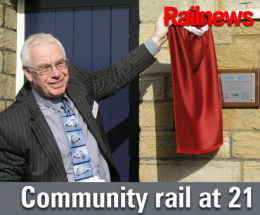Posted 14th March 2014 | No Comments
Community Railways celebrate 21st year

THE SUN came out in West Yorkshire to help supporters of Community Railways celebrate the 21st year since the idea was first promoted in Britain.
There are now well over 40 Community Rail partnerships, and passenger usage on the lines they support and promote has been rising fast.
The landmark was celebrated in another way, when the founder of Community Railways in Britain Paul Salveson unveiled a plaque on the new headquarters of the Association of Community Rail Partnerships in Huddersfield. The building, close to Huddersfield station, is anything but new, having built as the support for a locomotive water supply tank in the later nineteenth century.
It has now been meticulously restored and modernised to state-of-the-art eco-standards with the help of the Railway Heritage Trust and also European funding. The building now has an array of hi-tech equipment, including air-source heat pumps and photo-voltaic cells within the rooftop water tank itself, an air-exchange system that removes the need for air conditioning and a self-regulating lighting system that automatically switches on and off according to need.
Dr Salveson, who has become a visiting professor at Huddersfield University, joked that the first discussions about Community Railways began in his kitchen, before the embryonic Association gained its first separate office in a disused railway coach at Huddersfield station.
Later the ACoRP administrators moved to nearby Slaithwaite and have now returned to the Old Water Tower in the centre of Huddersfield.
Paul Salveson told Railnews: "I am very proud at what has been achieved -- it's quite spectacular -- but there is lots more to be done."
The Community Railway movement was given a boost when the Strategic Rail Authority published a keynote report in 2005, and although the SRA was later abolished its Community Railway policy has been continued since by the Department for Transport.
So far CRPs have been concentrated in England, but plans are now well advanced to adopt some Scottish lines, including the route to Stranraer.
